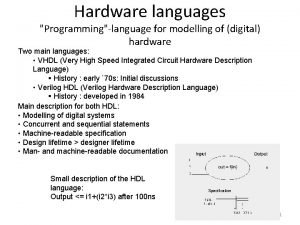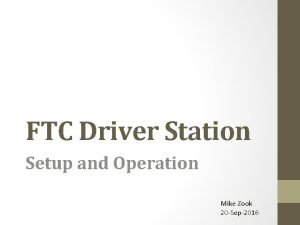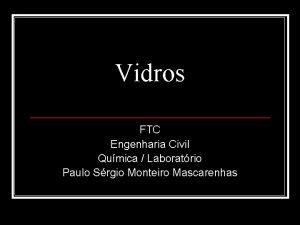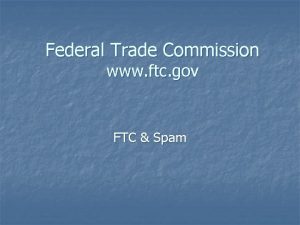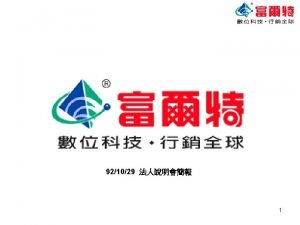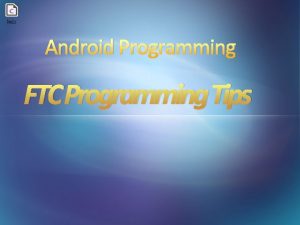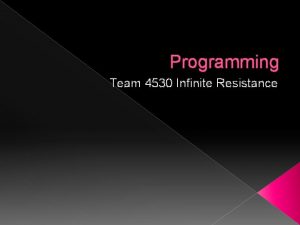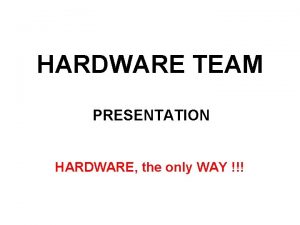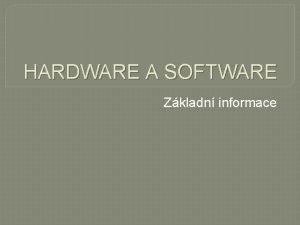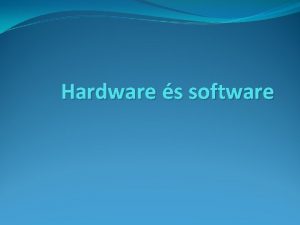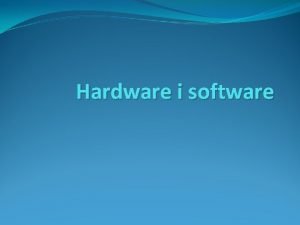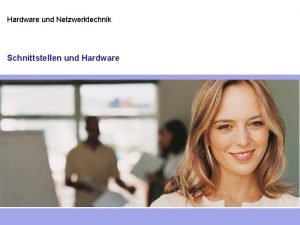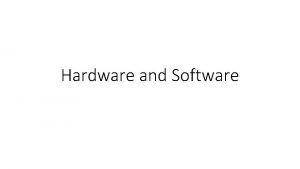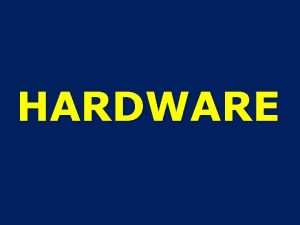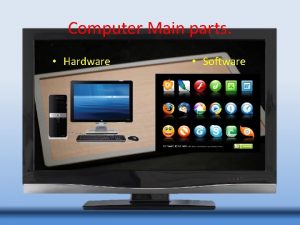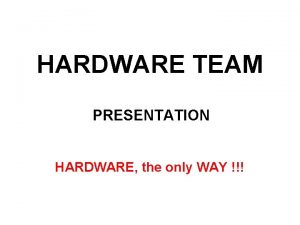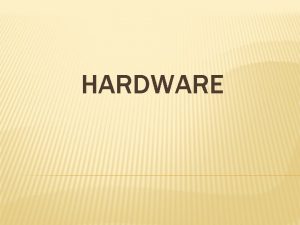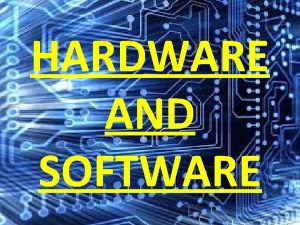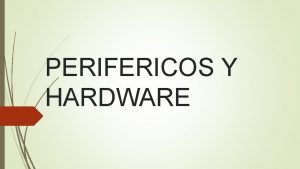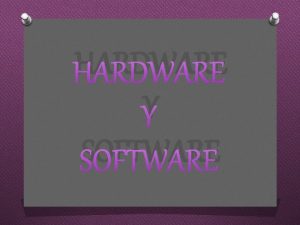FTC Programming Goals for Good Hardware Management FTC





















- Slides: 21

FTC Programming Goals for Good Hardware Management

FTC Programming – Android Studio Goals for good hardware management 2019 -2020 season kickoff class presented by: Vince Westin, Technical Evangelist, Dell Georgia FTC Lead FTA vincewestin@gmail. com

Building winning robots • Hardware without software – May look good, but won’t do much • Software without hardware – Nice code flow, but can’t do anything • Together, they make a winning robot – Good hardware to be able to achieve all goals – Motors for moving and lifting – Sensors for robot awareness – Software can make driving much easier for Tele. Op – Software to complete autonomous goals

Android Studio coding overview • Code written in C/C++/java or a derivative – A basic understanding of code flow is OK to start – Really knowing at least one language well is a big help • Driver station – Joysticks/controllers for remote robot operation – Fixed program (not modified) • With options for robot feedback display • Robot control – Custom for each team/robot – Understands the hardware installed – Code to manage wheels, other motors, servos, sensors, lights, etc. – Sample code for the tank robot is a great start

Preparing with Android Studio • Download Android Studio – https: //developer. android. com/studio/index. html • Download FTC code from Git. Hub (zipped folder) – https: //github. com/ftctechnh/ftc_app • Be sure you get this year’s 5. 0 code base (big changes) – Place under the Android. Dev folder, renamed for your team – Doc folder can be very useful – Your code will live in the Team. Code folder • DO NOT make changes anywhere else in the code tree • Set your phones in developer mode (see docs) • Create robot config to map software names to hardware – Stored as an XML on the phone, easier to edit on PC – Update for device serial numbers and such

Files on the phones • Only one app per phone (USB control conflict) • Use the Android Studio terminal window – Manual ADB commands • Driver app to driver phone – Updated app in docs/apk/ folder in Git. Hub download – Adb install doc/apps/Ftc. Driver. Station-release. apk • Robot control app is the one you will build – Best to skip the default robot app from Git. Hub download • Read robot config XML from the robot control phone – Adb pull /sdcard/FIRST/my. Config. Name. xml. – Adb push my. Config. Name. xml /sdcard/FIRST/ • Use the self inspection to verify everything is right!

Coding fundamentals • Hardware mapping – Definitions to create software ‘instances’ (handles) to control hardware – Motors and servos have speed/power, direction, and often position – Sensors can detect distance, color, weight, magnetics, etc. • Orientation sensing makes autonomous MUCH easier to program • IMUs are great! • Drive train – Motors to move the robot usually need to work together – Common drive train code creates a ‘virtual’ robot in software that is easy to move • Manipulation – Motors and servos can grab, lift, etc – often coordinated in groups

General Code Ideas • Use a core class to define your robot hardware (once) – Also include shared functions you will use – Extension of the Op. Mode class – Extend the others from this class • With versions in the names using @Tele. Op, @Autonomous • Build a test Op. Mode – Be able to check each motor, servo, sensor, etc. • Of course you need Tele. Op • And you need autonomous • Consider extending autonomous for each option (red/blue, …)

Sample tank class hierarchy • Rev. Tank. Core – hardware mapping… – Test – individual hardware control – Tele. OP – driver controlled robot – Auto – meat of autonomous code • Auto. Blue. Ground – set blue and no drop • Auto. Red. Drop – set red and drop • Auto. Red. Drop. Delay, same, but wait to start

Expansion Hub Inertial Motion Unit • Shows up as Sensor BNO 055 IMU – Provides heading, roll, pitch, gravity, … • Sample code for calibration and use – Included in the ‘external. samples’ folder of the repository – Calibration likely not needed • Sample tank code with class materials – Includes IMU-guided autonomous

Battery Power Sensor • Useful link to the battery sensor – https: //www. reddit. com/r/FTC/comments/3 odx 26/is_it _possible_to_get_the_battery_voltage/ – Link is in the sample code… battery. Volt. Sensor = hardware. Map. voltage. Sensor. get("Expansion Hub 1"); • Part of every Rev hub

Autonomous • Without sensors, you are floating blind – Orientation on the field (really critical, often missed – use IMU) – Distance traveled while moving – Color/distance sensing, etc. • Much harder to code than Tele. Op – Code for every situation the robot can encounter • And there a lot! – Sad to watch a robot wander off when it gets ‘fooled’ • Pre-set items like alliance color, field position, start delay, etc. • Usually based on a ‘state machine’ (working on goal YYY) – Now I am looking for a blue line – Now I am turning right 90 degrees – Now….

Tele. Op • Joysticks to drive train – Make it easy for the drive team – Things like slow/fine movement speed – Reversible ‘front’ • Manipulation control – Grab something – Tip/throw – angle and speed settings • Sensors – Detect line/color/weight and signal the drive team – Stop lift at certain target height(s)

Robot feedback • How will the team knows what the robot sees/thinks? – Feedback is critical to robot operation • Consider hardware feedback options – Raise arm/flag – Turn on a light (or a string of LEDs), change color – Will the team really notice under stress of competition? • Consider what the team needs to do – Feedback needs to inform/remind them easily (not blinking codes)

Managing complex situations • You are NOT the first person/team to solve this (in general) – What code have others shared that can guide you? – If not code, are there designs you can use to help speed things up? – ALWAYS document (code comments) ANY source that helps you along • Break big problems into smaller parts – Make the wheels move, then coordinate the drive train – Display a sensor reading, then combine with a motor/servo • Consider the control/software side while exploring hardware ideas – Hardware you cannot control reliably will not score points • Ask mentors for guidance – They may have others to ask as well – use the help!

Other challenges • You will write bugs – Finding them early can lessen the pain • Things do not always work – Hardware can fail – can the code adapt? – Sensors can give bad readings – can you skip one (or more) bad data points? • The season is short, but the challenges keep coming – Writing the perfect solution can take a lot longer than you think – Writing really complex code means it may be difficult to adjust as needed • You can share things across seasons – Need CLEAR documentation on what is old and what is new

Building the code • Code needs to be ready for practice EARLY – Drive teams need time to get comfortable – Look for ways to automate/simplify so driving is simpler/reflexive – A great robot without proper driving will lose badly • Add functions/classes to manage processes – Group hardware together to manage as a group (drive train, lift, etc. ) – Make them easy to add/remove for debugging • Hardware and software build can work in parallel – Software refining/debugging will be needed once hardware is done • Plan for programmer time with a dedicated robot • Plan for drive team time with working code • Plan to make LOTS of versions

Testing and automation • Things will break in competition (or transit or …) • Software can make hardware issues easier to find – Be able to control every motor/servo separately – Be able to control systems together (drive train, …) – Be able to verify/test each sensor (orientation, power, distance, …) • Do you need to test for things that shift? – Check belt tension/skipping – Check for slippage in drive train, gear set, chain gear, … • What can be automated? – Maybe force a checklist to be completed to start autonomous? – Can you built a test of a launch system that checks the distance?

Documentation and backups • Did you come up with a great piece of code? – Who wrote it/when? – What inspired it? – Use code comments to be able to remember • Is there something really not obvious about your code? – How can you explain it so another programmer can jump in and help? – How can you comment it so that a judge can easily understand? • Keep lots of backups – Weekly at least, plus after each breakthrough, plus others because you can – Copies on one system are NOT backups! • Spread them around (or cloud share) – For multiple programmers, have an easy way to share/merge updates • Check for updates from FIRST on code repositories regularly – Code updates can happen WEEKLY – Some of the issues they find/fix may be things driving you nuts….

Join in the Discussion on Slack • GA FTC Coaches & Mentors – Team organization, fundraising, recruiting, hosting, etc. • GA FTC Resources – Everyone and everything team related! • Send an email to vincewestin@gmail. com

FTC Programming – Android Studio Goals for good hardware management 2019 -2020 season kickoff class presented by: Vince Westin, Technical Evangelist, Dell Georgia FTC Lead FTA vincewestin@gmail. com k n a h T ! u Yo
 Strategic goals tactical goals operational goals
Strategic goals tactical goals operational goals Strategic goals tactical goals operational goals
Strategic goals tactical goals operational goals Hardware map ftc
Hardware map ftc Ftc blocks programming
Ftc blocks programming External hardware
External hardware Good thoughts good deeds good words
Good thoughts good deeds good words Hi good good
Hi good good Good evening students
Good evening students Nothing compares to your embrace
Nothing compares to your embrace Good afternoon me
Good afternoon me General goals and specific goals
General goals and specific goals Motivation in consumer behaviour
Motivation in consumer behaviour What is hdl hardware description language
What is hdl hardware description language Hardware programming language
Hardware programming language Perbedaan linear programming dan integer programming
Perbedaan linear programming dan integer programming Greedy vs dynamic
Greedy vs dynamic What is system programing
What is system programing Linear vs integer programming
Linear vs integer programming Definisi linear
Definisi linear Mark seidman ftc
Mark seidman ftc Driver station
Driver station Ftc engenharia civil
Ftc engenharia civil













